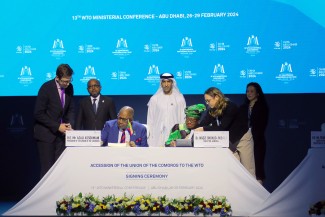KEY RESULTS
- The Enhanced Integrated Framework (EIF)'s support to the honey sector in Zambia increased production, improved the quality of the honey and protected the environment. This directly resulted in income from exports increasing from USD 684,000 in 2011 to USD 6.09 million 2022.
- The EIF and the World Trade Organization (WTO) Standards and Trade Development Facility (SDTF) collaborated on a Sanitary and Phytosanitary project to connect Zambian entrepreneurs with improved export‑quality infrastructure. This led to the export of blueberries to South Africa and avocados to the European Union, improving livelihoods at the grassroots level.
- SheTrades Zambia, a collaborative project between the EIF and the International Trade Centre (ITC), catalyzed the effects of scale and led to the creation of a second SheTrades programme. Women entrepreneurs experienced an increase in sales, 126 jobs were created in the first project, and 12 new export markets were developed.
Zambia has for a long time dominated the African trade market as the largest exporter of copper, producing 70% of the continent’s volume. Copper makes up 60% of the country’s total exports and 12% of its gross domestic product. This dependence on mining, combined with some agriculture, renders the Zambian economy vulnerable to fluctuations in both global prices and demand, as well as climatic shocks.
With support from the EIF, Zambia intensified its trade growth and diversification efforts directed at different levels to achieve systemic improvements. These were: first, on strengthening linkages to both the private sector and the Government around key products, such as honey; second, on building the institutional capacity of the Government and trade-related organizations, mainstreaming trade in the country’s development framework, and improving the trade regulatory environment; and third, exploring new markets for Zambian products.
Capacity-building as a starting point
Government support began with creating and then building the capacity to implement, monitor and coordinate Aid for Trade initiatives within the Ministry of Commerce, Trade and Industry (MCTI), and to formulate trade-related policies, notably the trade policy and export strategy.
The Ministry also worked through public universities to introduce a trade policy and development course. As part of this endeavour, and with the support of the National Board of Trade (NBT) of Sweden, lecturers attended the Trade Academy Course —an advanced trade policy programme organized by the NBT— to enhance both their pedagogical methods and trade policy skills. In collaboration with the Ministry, the NTB also facilitated the production of a harmonized textbook on trade policy and development.
He believes the course develops capacity and analytical skills among students to be able to respond to the growing demand for understanding international trade issues once they are employed. Several of the University’s graduates are now employed in government, quasi-government institutions, and in the private sector.
Lilian Bwalya, Permanent Secretary at the MCTI, says that before this intervention, graduates were leaving university with a gap in their understanding. However, since the introduction of this course, the country now has a pool of experts with knowledge of international trade policies and skills in trade mainstreaming, policy formulation, and strengthening trade negotiations.
Value in economic diversification
As part of its economic diversification strategy to reduce dependence on copper, the Government identified honey as one of the country’s high-value export products with significant room for growth. Working together with SNV Netherlands Development Organisation, beekeepers received 5,000 modern beehives, 4,000 sets of protective clothing, 5,000 harvest and storage buckets, and 2,000 smokers. This led to increased production, improved the quality of honey and protected the environment.
The infrastructure also enabled more women to participate. Using the training-of-trainers approach and working with the Zambian Forestry College, 6,580 beekeepers were trained. Further, beekeepers were organized into groups and established ongoing relationships with honey processors. Eighteen (18) bulking centres were established to provide centralized packaging, storage and marketing services. All these interventions resulted in income from exports increasing from USD 684,000 in 2011 to USD 6.09 million in 2022.[1] Moreover, the successes of the honey sector – in the form of significantly increased export revenues and livelihood opportunities for producers – have catalyzed financial support from other funders to reinforce value chains in this sector. Notably, the Africa Development Bank's, Africa Trade Fund provided USD 1.4 million with the backing of the Government of Canada, a direct outcome of the EIF support.
Returns on investments for women
Together with ITC, the EIF helped launch the SheTrades initiative in Zambia, providing catalytic support to increase the participation of women-owned businesses by enhancing their competitiveness, strengthening market linkages and enabling their inclusion in agricultural, textiles and garments value chains. “Through the SheTrades project, women entrepreneurs participated in regional and international trade fairs where they identified new markets for their products and additional business opportunities,” says Nyirongo.
SheTrades has trained, mentored and coached 200 women, with more than 400 on its database having benefitted from various services. During the 18 months of implementation, SheTrades contributed to over USD 3 million in new sales, created 126 new jobs, of which 79 were filled by women, and grew exports to 13 regional and 12 international markets in 2020. The SheTrades Hub in Zambia partnered closely with the Zambia Development Agency, a government agency under the MCTI, which is the long-standing government host of the EIF initiative.
Following the success of this partnership, the EIF has replicated the initiative with ITC in other least developed countries (LDCs) such as The Gambia and Rwanda. Although the project itself has come to an end, the MCTI continues to leverage and target support for women entrepreneurs to expand their businesses by participating in regional trade fairs and conducting exploratory trade missions to neighbouring countries to seek new markets. In 2022, the Government also received support from the Government of Finland for two trade missions to the Democratic Republic of Congo (DRC), which generated new business in textiles, food and beverages, and safety clothing. The Trade Mission to the DRC built on the market research undertaken in DRC by the Zambia Development Agency, which was facilitated by the EIF project. The SheTrades project in Zambia entered its second phase with support from EIF, extending its duration through 2022 and 2023.
Transforming cooperatives
Through the Cooperatives Development and Sustainability Project, 174 cooperatives, with a total of 1,864 cooperative members, have been transformed into well-organized coordinated businesses with business and governance structures in place. These cooperatives are a source of employment and livelihoods for many and are now contributing to the country’s economy more formally. As stated by Nyirongo, “Changing the mindset of cooperatives to operate as businesses was a big win because many cooperatives were just operating without structures.” The EIF provided the cooperatives with services such as training of District Cooperative Officers and logistical support, as well as linking them with financial institutions and other service providers. District Cooperative Officers provide further training aimed at strengthening the activities of honey, edible oils, maize, pineapple, dairy, moringa and gold producers and processors. This initiative leveraged the experience of Uganda, which had implemented a similar project through EIF support.
Improved sanitary and phytosanitary capacity boosts trade
Sanitary and phytosanitary regulations constrain market access for many of the products produced by cooperatives and private sector companies, with many products being rejected and leading to significant losses. In partnership with the STDF, national authorities in Zambia have worked hard to address challenges in handling horticulture, arable and floriculture products, to reduce notifications on detected pests. As a result, notifications of pests have reduced significantly since 2017.
The Government is actively involved in developing phytosanitary policies and standards, both nationally and together with other countries in the region, as well as improving capacities in plant and quarantine services to increase the confidence of trading partners, especially member states of the Southern African Development Community.
Mainstreaming is key to growth and sustainability
Nyirongo underscores the uniqueness of the EIF programme’s support to the Government of Zambia:
The EIF supported the Government’s efforts, from identifying sectors with capacity to stimulate and grow trade; assisting with planning activities and ensure they are mainstreamed in national strategies and plans; building capacity to strengthen resource gaps; understanding, and providing support to a sector’s value chain; and building the necessary infrastructure.
To facilitate national ownership and integration of the EIF National Implementation Unit (NIU) functions and projects into government structures, for example, the MCTI hosts both the Government-Donor platform and the National Trade Facilitation Committee Secretariat (NTFCS), which was established under the Border Management and Trade Facilitation Act of 2018. The role of NTFCS, equivalent to the National Steering Committee, is to coordinate resource mobilization; implement the Diagnostic Trade Integration Study (DTIS) matrix of recommended activities; monitor results and impact and support the implementation of the Trade Facilitation Management Agreement. The NTFCS services the high-level National Trade Facilitation Committee, which is chaired by the Secretary of the Cabinet.
The Government, with the support of the Common Market for Eastern and Southern Africa and the European Union, is implementing regional and national Aid for Trade projects that will continue beyond the ongoing EIF support. In addition, the EIF is supporting the Ministry in preparing several proposals for follow-on activities after the current projects end. To facilitate the prioritization of areas for possible support, the Government in Zambia finalized a DTIS Update in June 2023, pending official government launch before the end of 2023, that will have a focus on, among others, market access research after Zambia's graduation from the LDC category in the region and globally, and the nexus between trade and climate change. This is the third DTIS that the country is undertaking, and it is keen to mobilize support from development partners for its Action Matrix priorities over the coming years.
_ _ _
As the second phase of the Enhanced Integrated Framework (EIF) comes to an end in 2024, the objective is to produce a catalogue of impact stories showcasing the efforts of the EIF partnership in the least developed countries (LDCs) and recently graduated LDCs where it has been actively engaged. This impact story makes up one of the stories in the catalogue. Essential input and reviews were received from the country‑based EIF National Implementation Units (NIUs) and the wider EIF team.
The primary objective of each impact story, as well as the entire catalogue, is to adopt a journalistic approach in recounting the EIF's engagement in the LDCs during both Phase One and Two. The aim is to offer valuable insights and to document outcomes and impacts, as well as some lessons learned from the work of the EIF partnership in the LDCs. These stories do not provide a comprehensive overview of every aspect of EIF partnership engagement such as precise timelines or the exact extent of involvement (i.e., financial contributions). Instead, they serve as one of several means of information about the work of the EIF partnership. Interested readers are encouraged to supplement these impact stories by consulting other sources, including EIF Annual Reports, Trade for Development News articles, EIF social media channels, and, where applicable, the NIUs in the LDCs as well as the EIF Executive Secretariat.
It is essential to acknowledge that the information provided is neither exhaustive (e.g., it is based on the latest available data at the time of writing in 2023) nor evaluative in nature.
Lastly, while each impact story adheres to a similar structure, the diverse range of countries, contexts, and EIF engagements means that each story is unique.
[1] Trend Economy, Annual International Trade Statistics by Country (HS) https://trendeconomy.com/data/h2/Zambia/0409
If you would like to reuse any material published here, please let us know by sending an email to EIF Communications: eifcommunications@wto.org.


